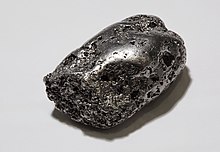
Back فلز طبيعي Arabic Təbii metallar Azerbaijani Metall natiu Catalan Metal nativo Spanish Metal natibo Basque فلز بومی Persian Métal natif French Logam asli ID Metallo nativo Italian Табиғи металдар Kazakh

A native metal is any metal that is found pure in its metallic form in nature.[1][2] Metals that can be found as native deposits singly or in alloys include antimony, arsenic, bismuth, cadmium, chromium, cobalt, indium, iron, manganese, molybdenum, nickel, niobium, rhenium, tantalum, tellurium, tin, titanium, tungsten, vanadium, and zinc, as well as the gold group (gold, copper, lead, aluminium,[3] mercury, silver) and the platinum group (platinum, iridium, osmium, palladium, rhodium, ruthenium). Among the alloys found in native state have been brass, bronze, pewter, German silver, osmiridium, electrum, white gold, silver-mercury amalgam, and gold-mercury amalgam.
Only gold, silver, copper and the platinum group occur native in large amounts.[citation needed] Over geological time scales, very few metals can resist natural weathering processes like oxidation, so mainly the less reactive metals such as gold and platinum are found as native metals. The others usually occur as isolated pockets where a natural chemical process reduces a common compound or ore of the metal, leaving the pure metal behind as small flakes or inclusions.
Metals are not the only type of chemical element that can occur in the native state. Non-metallic elements occurring in the native state include carbon, sulfur, and selenium. Silicon, a semi-metal, has rarely been found in the native state as small inclusions in gold.[4]
Native metals were prehistoric man's only access to metal, since the process of extracting metals from their ores (smelting) is thought to have been discovered around 6500 BC. However, native metals could be found only in impractically small amounts, so while copper and iron were known well before the Copper Age and Iron Age, they did not have a large impact until smelting appeared.

- ^ "native metal". Oxford English Dictionary. Oxford University Press. Archived from the original on January 31, 2018. Retrieved 30 January 2018.
- ^ Parker Cleaveland (1822). An elementary treatise on mineralogy and geology. Cummings and Hilliard. p. 521.
- ^ Barthelmy, D. "Aluminum Mineral Data". Mineralogy Database. Archived from the original on 4 July 2008. Retrieved 9 July 2008.
- ^ Silicon, Mindat.org